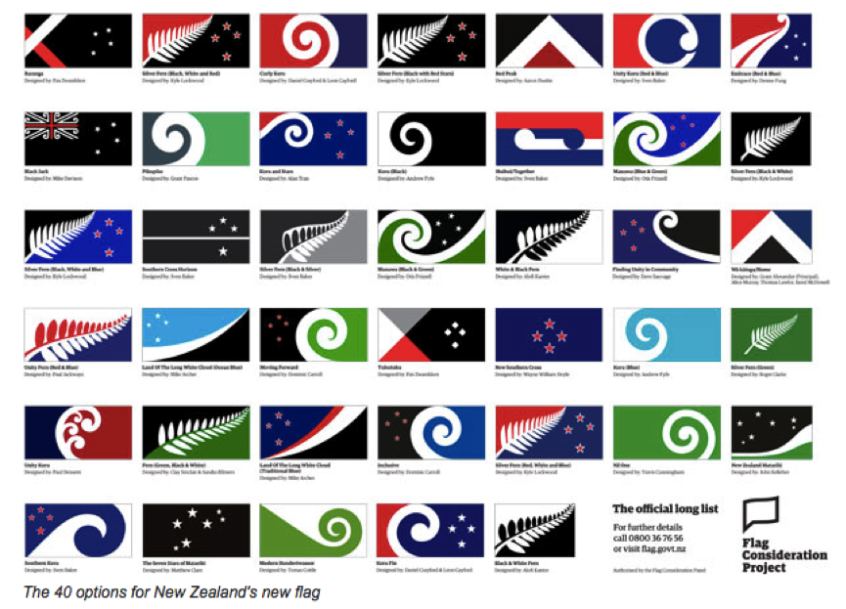The Flag Consideration Panel has published its “long list” of 40 entries from the 10,000 plus it has sifted through.
And an overview of all 40 tells us in no uncertain terms what the dominant preference of the panel is for – it’s for the southern cross, the silver fern and the koru. Only two entries don’t have at least one of those traditional icons of kiwiana in their pattern.
Some will see that as a lack of ambition and vision on the part of the panel, others will see it as an endorsement of the symbols that we are all familiar with – two parts of a plant and the sky we rest beneath. Given it is the public that will be making the final choice it is clear that the panel are assuming the public’s imagination and capacity for innovation is severely limited.
The good news of course – which we should all celebrate – is that the panel has managed to agree that the Union Jack has to go. Much as modern day Aotearoa New Zealand has a lot to thank Britain for, having the remnants of a defaced British naval ensign on our flag is a resounding insult to Maori. It is now accepted that Hobson’s May 1840 unilateral declaration of colonisation was unlawful and our constitutional foundation is the Treaty of Waitangi. This renders the flag of convenience the British concocted to ‘legitimise’ the post-1840 treaty breaches well past its used-by date. It is an insult to all New Zealanders now.
But from the start of the flag design exercise the design community has criticised the flag consideration panel for its lack of vexillology expertise. The concern has been this panel would struggle to transition our flag away from a relic of colonisation to one that identifies us for who we are; one of the world’s most multicultural societies with a unique bilateral founding document.
And when 37 of the 40 preferred entries are permutations of stars and fern parts, it is difficult to disagree with that perspective. Where is the story that underpins the designs that communicates to our children what our flag stands for? Three of the strongest flags in the world – those of Britain, the US, and South Africa – all signify the particular national stories. The Union Jack is a clever compilation of the crosses of 3 members, the Stars & Stripes tells how 50 states emerged from the original 13, while the Rainbow Nation acknowledges the plethora of tribes that built South Africa.
Determining a flag design is not akin to choosing a corporate logo – despite John Key’s preference that it be exactly that. We have plenty of those – Zespri, Fonterra, the All Blacks all have great logos. The flag is as much about the story of the nation as it is about being a pretty picture. And most of the 40 chosen have very little story. They are what the designers have called a ‘cut and paste’ collage of various slices of kiwiana – much as one would expect on a tea towel that tourists take home. If we’re heading down that path where are the geysers, tikis and kiwi birds to flesh out the memories?
Finally the Flag Consideration Panel itself has acknowledged some of the properties a flag should have – properties that the practice of vexillology have derived over centuries and centuries of flag symbolism. It needs to remember those when choosing its final four – especially the following:
- Simplicity – can a child draw it? If we want it used as widely as possible, we must all be able to draw it. Try drawing a silver fern!
- Recognition – can it be recognised from a distance? Try doing that with a collage of kiwana.
- Meaning – what do the pattern and the colours actually mean? Canada has a dead leaf – pretty but superficial, it’s no more than a logo. The silver fern would be similar. How does a dead leaf convey to anyone who we, the New Zealanders are?
It is clear that the Flag Consideration Panel – a group of distinguished New Zealanders – want a flag that is indicative of New Zealand. And for that they must be congratulated and any progress encouraged. But I would urge them to consider all the aspects of vexillology they have quoted, when they put forward their final four. They must avoid the kiwiana tea towel syndrome and eschew the shallow temptations of corporate logos and PR. Instead they must look for entries that are inspirational for all New Zealanders, respectful of the rich diversity of cultures that comprise our multicultural modernity, and convey who we come together as, what being a New Zealander means. The flag the new South Africa chose is not a bad template actually.
Good luck with that.

